Delicious and aromatic tomatoes that look like giant berries - the amazing German Red Strawberry tomato
The tomato of the German Red Strawberry variety bears this name for its resemblance to a huge garden berry. It is also clear from the name that the variety was bred in Germany. It appeared in Russia 30 years ago. It gained popularity among Russian summer residents precisely for the unusual shape of the fruit, which looks like a huge strawberry. In 2015 it entered the top 10 most popular varieties.
The content of the article
Description of the variety
Mid-season indeterminate variety. Suitable for growing in greenhouse conditions. In regions with a hot climate, a good harvest is obtained when planting in open beds. In a warm, dry summer, the fruits ripen faster, and therefore some farmers attribute the variety to early maturing. Suitable for growing in central Russia.
Tomatoes of this variety come in two colors - pink and orange.
Distinctive features
The plant is classified as a tall variety. The bushes reach a height of 2-2.5 m in greenhouses, in open ground - 1.2-1.8 m. The bush is moderately leafy, with medium-sized dark green leaves. On one hand, an average of 4-6 fruits ripen. Ripening begins simultaneously at 95-116 days.
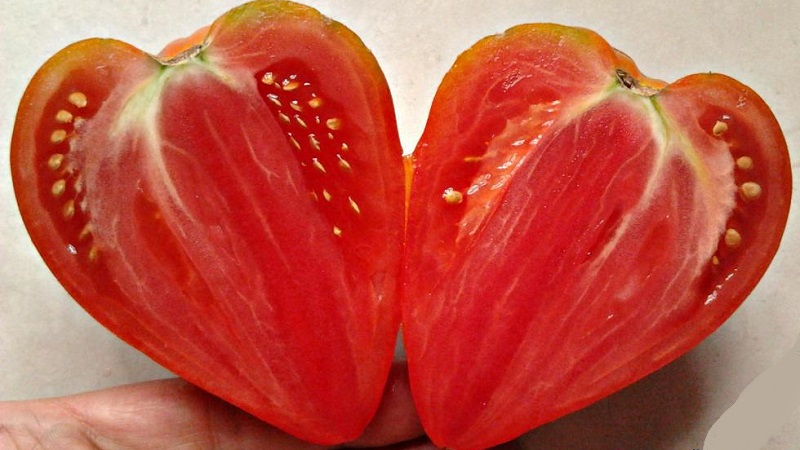
Fruit characteristics and yield
The berries are red-pink or orange in color with soft, sugary flesh and few seeds. The color is even, there are no spots or stripes. The skin is smooth and thin, but the fruit does not crack during transportation. Fruit weight - 150-300 g, but with proper care it reaches 500-600 g.
By taste, tomatoes sweet, with a slight sourness.
The yield, according to the producers, is up to 8 kg of fruits per plant.
How to grow seedlings
When planting in a greenhouse, a seedling method of cultivation is recommended; outdoors in warm regions, it can be planted with seeds. Seeds are planted for seedlings in early to mid-March. Consider how grains are prepared for seedlings.
Seed preparation
First of all, calibration is carried out - suitable grains are selected. The seeds are poured out and examined. The seeds suitable for planting should be large, even, not empty to the touch. Light, uneven, hollow seeds are thrown away.
The selected grains are placed in a saline solution: dissolve a tablespoon of salt in a glass of water. The duration of the procedure is 15-20 minutes. Seeds that have sunk to the bottom are taken for planting, those that have floated to the surface are rejected.
Next, the seeds are heated by placing them on a cotton cloth on a battery. There the seeds are kept from 1.5 to 2 days.
At the next stage of preparation, the planting material is disinfected. For this, a 1% solution of potassium permanganate is prepared and grains are placed in it for 15-20 minutes. The maximum procedure time is 45 minutes
Important! Potassium permanganate will destroy infectious agents that live on the surface of the seeds. It does not affect diseases, the causative agents of which are inside the grain.
After disinfection, the seeds are washed with warm running water.
The dressing of purchased seeds is not necessary, this procedure has already been carried out during packing. However, if the planting material was obtained from last year's tomatoes, disinfection is necessary.
Next comes an interesting stage - bubbling. Many gardeners skip it because it requires constant presence.And in vain - it saturates the grain with oxygen, which increases the germination of seeds and the viability of seedlings.
In industrial conditions, bubbling is performed with special equipment. At home, for this, the seeds are placed in water heated to +26 - +30 degrees and stirred every hour. The duration of the procedure is 15-18 hours.
Important! If embryos appear on the grains, the bubbling is stopped.
After the planting material is soaked in water or biostimulants. The grains are placed in a liquid with a temperature of at least +20 degrees for 12 hours. Popular biostimulating drugs among Russian summer residents are "Zircon", "Epin", "Immunocytofit".
The next stage is hardening. The seeds are wrapped in cotton cloth and plastic wrap and placed in a cool place for 8 hours, where the temperature does not rise above +2 degrees. The minimum air temperature is -3 degrees. The seeds are removed and kept at room temperature for 8 hours. The procedure is repeated up to 6 times.
Note! This is a complex procedure, if carried out incorrectly, there are great chances of destroying the seeds, therefore, it is not recommended for novice gardeners to harden all the seeds.
The last stage before planting is seed germination. A cotton cloth or gauze is moistened with warm water and laid out on a flat dish (saucer, Petri dish, lid). Seeds are laid out on top and covered with a layer of fabric. For germination, the grains are placed in a warm (+ 25-30 degrees) place and make sure that the fabric always remains moist. When a 2-3 mm sprout appears on the grains, the seeds are ready for planting.
Capacity and soil
Any convenient container is suitable for seedlings: plastic cups, cut PET bottles, special containers. Before use, the container is disinfected with a cool solution of potassium permanganate.
A universal tomato soil mixture consisting of humus, peat and river sand is suitable for tomatoes of the German red strawberry variety.
To prepare the ground for tomato seedlings on your own, connect:
- 1 part of the garden land (it is better to take from the area where cucumbers, zucchini, carrots, dill grew);
- 2 parts of non-acidic peat (pH 6.5);
- 0.5 parts of sand (river or washed);
- 1 part humus or sifted mature compost.
You can add sifted wood ash (or dolomite flour), sphagnum moss and fallen needles.
The day before planting the seeds, the soil mixture is disinfected with boiling water or potassium permanganate.
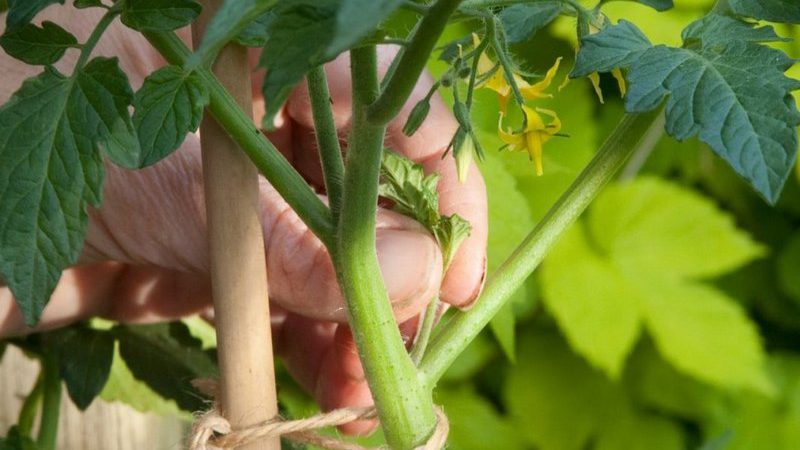
Sowing
The earth is laid out in the selected containers, shallow (1.5-2 mm) grooves are made, where the seeds are laid. The soil is sprayed, the containers are covered with foil and removed to a warm (+23 degrees), bright place.
Important! Tomato seedlings do not like direct sunlight, preferring diffused light.
Growing and care
In favorable conditions, sprouts appear in 3-5 days. Once this happens, the film is removed from the containers and placed on a windowsill. Root watering is carried out as the soil dries up with a syringe or a teaspoon.
After 2 weeks, 2 true leaves will appear on the plant, then they begin to pick. Mineral fertilizers are added to the soil for transplanting at the rate of 1 tbsp. spoon for 5 liters of soil mixture. Holes are made in the container so that excess liquid does not stagnate in the soil when watering.
Small plants are planted in separate containers, ground with earth to the cotyledon leaves. 10 days after the pick, the first fertilizing is carried out with complex fertilizer. Further feed every 10-14 days until planting in the garden.
Water as the soil dries up and be sure only at the root, avoiding liquid getting on the leaves. 2-3 weeks before disembarking at a permanent place, the seedlings begin to be taken out into the open air: a balcony, a summer veranda. This tends to accustom the plants to lower temperatures and sun rays.
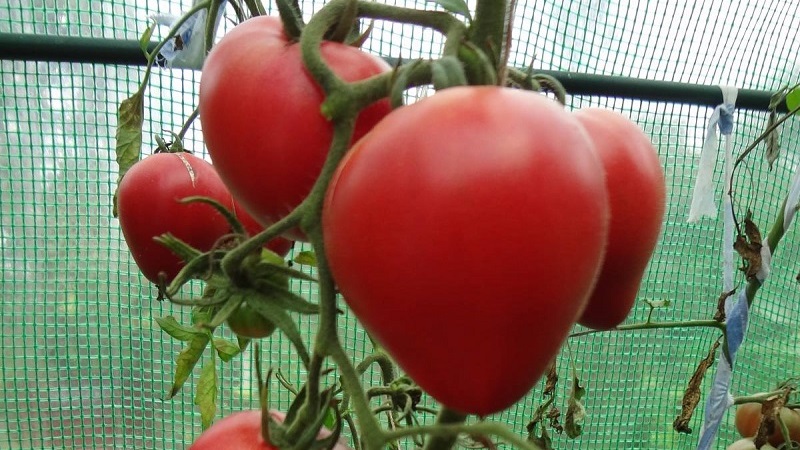
How to grow tomatoes
Planted seedlings to the garden in mid-May (in the greenhouse) - early June (open ground) after the establishment of a constant above-zero temperature.
Important! In warm regions, they are planted earlier. Plants, ready for planting in the ground, reach 20 cm in height.
Landing
Tomatoes are planted on the south or southeast side of the garden. Choose a place where cucumbers grew, zucchini, dill, parsley. The crops of the nightshade family (tomatoes, potatoes, bell peppers) are poor predecessors, since these plants are susceptible to similar diseases and suffer from the same harmful insects. The minimum distance between tomato bushes is 50 cm.
Care
The bushes are watered only with warm, settled water. With each watering, weeds are weeded and the soil is loosened. They fertilize 3-4 times during the summer, alternating mineral and organic fertilizing.
Important!Tomatoes love water, but in moderation. Maintaining the correct humidity level is an important maintenance requirement.
Variety indeterminate, therefore, pinching is carried out in one stem. Tall bushes (120-250 cm) need a garter.
To avoid rotting tomatoes, the lower leaves are torn off.
Features of cultivation and possible difficulties
Experienced gardeners closely monitor the formation of the ovary - the deformed flowers are removed in order to stimulate the growth of a good ovary and thereby increase the yield.
With improper care, the fruit can form a "non-strawberry" shape. In this case, the frequency of watering and feeding is changed.
Diseases and pests
Producers assure that the variety does not suffer from pathogenic infections. However, in practice, especially in cool, rainy summers, tomatoes often get sick late blight, brown spot, gray rot.
To prevent fungal diseases, the soil is spilled with a hot solution of potassium permanganate before planting seedlings. Biological and chemical preparations will help prevent and reduce the spread of fungal diseases:
- Fitosporin;
- Ecosil;
- Fundazol;
- "Quadris";
- Ridomil Gold.
For reference.Our summer residents use milk whey for the prevention of late blight (fat content - no more than 1%, otherwise the leaves can be burned). Immediately after transplanting seedlings into the ground, the bushes are sprayed with serum. The procedure is repeated every 10 days.
Diseased plants are immediately destroyed to avoid contamination of the entire planting. Green fruits can be removed, disinfected in hot (+60 degrees) water for 2-4 minutes. Garden tools are also treated with drugs.
Bushes are regularly inspected for harmful insects. If they are found, tomatoes are treated with special chemicals according to the instructions. Colorado potato beetle, whitefly and scoop are destroyed with "Oppercut" or "Aktara". But they do this only before the ovary appears.
There are also popular, but well-proven methods of dealing with tomato pests... For example, thrips, spider mites and whiteflies are afraid of celandine broth, slugs are afraid of ammonia, and aphids are afraid of a solution of laundry soap.
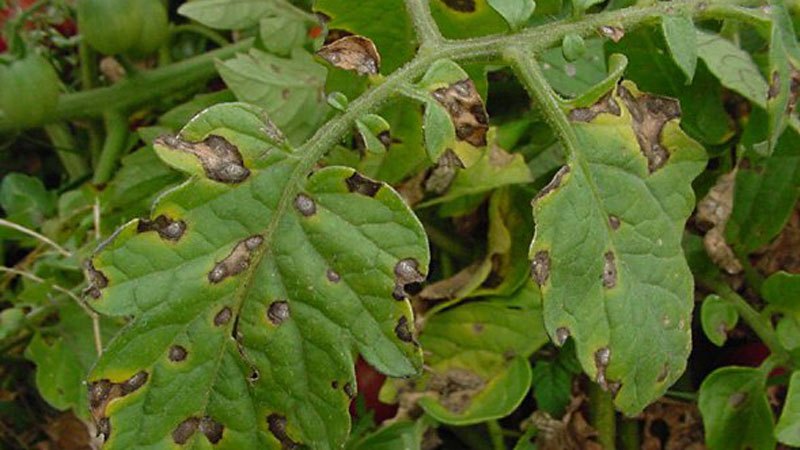
The nuances of growing in an open field and a greenhouse
When planted in open ground, the German "strawberry" tomato is covered with a covering material for 2-3 weeks. After a while or when warm and dry (both at night and during the day) weather is established, the material is removed. Some summer residents, planting German strawberries in open ground, form a bush of 2-3 stems.
In greenhouses, moisture is not allowed to rise, because fungal spores can penetrate the plant with water droplets. Water only at the root, and remove the lower leaves so that the rest of the bush is well ventilated and dried.
Harvesting and application of the crop
The fruits ripen together. They are harvested both ripe and still green - they will "reach" at room temperature. Ripening occurs on day 95-116.
An excellent variety for fresh use, salads, soups, for making juice, lecho, sauces, pastes and snacks. But for canning as a whole, the variety is not suitable - large fruits do not keep their shape and, due to the fleshy pulp, easily fall apart.
Advantages and disadvantages of the variety
The advantages of the variety include early ripening and easy care, excellent taste, the original shape of the tomatoes and the color of the fruits.
The disadvantages are the need for pinching and garters, susceptibility to fungal infections, a decrease in yield on barren land without fertilization.
Farmers reviews
Farmers note the interesting shape, bright tomato flavor, color and size of the fruit. Tomatoes are suitable both for fresh consumption in salads and for preservation. In addition, German Red Strawberry has earned positive reviews for its easy care. However, some do not like the variety - because of the need for pinching and forming a bush.
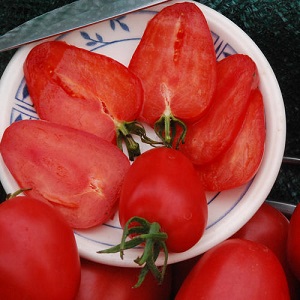 Irina Dudina, Moscow region: “I planted orange strawberries this year. The color is normally bright orange, amber or yellow, depending on the crossing. The fruits can be used fresh or for making jams, juices, pickling. Whitefly attacked this year, but got rid of it quickly, the tomato did not suffer. "
Irina Dudina, Moscow region: “I planted orange strawberries this year. The color is normally bright orange, amber or yellow, depending on the crossing. The fruits can be used fresh or for making jams, juices, pickling. Whitefly attacked this year, but got rid of it quickly, the tomato did not suffer. "
Lyubov Ilyasova, Samara: “I liked the variety for its yield, the whole bush was covered in tomatoes. They write that keeping quality is bad, but I forgot the ones that were plucked in the basin for a month - none of them deteriorated. The color of ripe fruits is different: from pinkish to bright red. Very tasty! Left the seeds. I will definitely plant more. "
Elena Kudrina, Belgorod: “The height of the bush is 2 meters, the weight of the fruit is 350 g, the beautiful shape is the heart. Insanely delicious, aromatic, juicy, sweet! The bush is huge and knits from beginning to end of the bush. High yielding! I amazed with its power. This is the first tall large-fruited variety that knits throughout the bush. I highly recommend boarding! "
Andrey Timakhov, Rostov-on-Don: “The fruits of the German berry are tasty and of the correct shape only when the soil is fertile, when there is constant feeding and sufficient watering. You also need to remember to form a bush into two stems, no more, otherwise the food will go into the foliage. These nuances can be considered disadvantages, but there are a lot of advantages: tasty, juicy, well kept. "
Conclusion
Tomato German Red Strawberry is suitable for cultivation in greenhouses and outdoors. It does not require special care, but a garter and the formation of a bush into one stem is necessary. It is susceptible to fungal infections and does not bear fruit well on poor, depleted soils.
Loved by summer residents for sweet, aromatic, fleshy fruits of an unusual shape. Great for fresh salads, juices, snacks and sauces. Up to 8 kg of berries are harvested from the bush. Suitable for growing by beginner gardeners, but requires careful care from them.